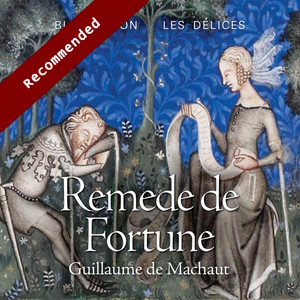
Guillaume de Machaut (c.1300-1377)
Remede de fortune
Blue Heron/Scott Metcalfe, Les Délices/Debra Nagy
rec. live, 26-27 April 2019, First Church in Cambridge, Congregational, Cambridge, USA
BLUE HERON BHCD1012 [72.51]
La remède de fortune (“fortune’s remedy”, also meaning “the makeshift cure”) is a rambling, four-thousand-word narrative love poem which contains seven songs, each in a different form. It has been dated sometime after 1345. There are a Lai, Ballade, Baladelle, Rondeau and Virelai, which were common at the time, plus a Chant royal, Machaut’s only example, and a Complainte. The first track is Ci commence (“here begins”) which Scott Metcalfe beautifully reads in French.
Here are the salient points of the storyline. The Lai (track 3) was the writer’s undoing. We see him writing it on a scroll on one of the many gorgeous manuscript reproductions. He was writing in praise of his lady but she finds it by accident and asks if it might be read to her. The author runs away in embarrassment. This resulted in the Complainte; typical of Machaut, he muses (in what in this performance is an eleven-minute monody) on the vagaries of fate and love. Hope makes an appearance, and this results in Machaut’s Chant royal, and shortly afterwards a Baladelle. In both pieces hope praises love and gives Machaut confidence – so much so that he composes a Ballade without music. He can now dance again, hance a Virelai. Once the lady has discovered the author of the Lai, she invites him back to her château where there is dancing and singing. Rings are exchanged and this inspires the author to write a Rondeau which ends the sequence of poetry and music – although the lady rejects him at the end.
You will notice that we have more than seven tracks. The performers fill the programme out with other appropriate pieces, including a few motets, a section from Machaut’s famous Mass, a piece by Machaut’s predecessor Lescurel, and an Estampie. The performances, then, are only occasionally a capella, and that there is a subtle but liberal use of instruments. We get a recorder, fiddle, harp, percussion and hurdy-gurdy, and the rather mysterious douçaine. This is a double-reed instrument, rather mellow and sweet-sounding; its resonance beautifully matches the voices, especially in the solo Complainte (which, you will be glad to know, has been edited down from thirty-six stanzas to just four). There are some instrumental passages, and non-texted parts are played by instruments. Debra Nagy has composed other instrumental sections based on the original melodies.
If I had to name one wonderful thing about the singing, it would be the carefully aligned medieval French vowels. Another choice would be the subtle phrasing, always difficult in Machaut whose sound-world can appear rather weird, it must be admitted. I would also add that’s Blue Heron’s tempi seem ideal and hold one’s attention.
Performing live this extraordinary poem with music must pose a number of problems. The disc is an outcome of two live performances, remarkably devoid of audience disturbance.
This is one of the most beautifully and lavishly made discs that has ever come my way. The firm cardboard outer shell contains a boklet with illustrations, photographs of the performers, clear texts (well translated) with a short resume between the songs, and a biographical essay at the end which also notes on the background to how the group decided to record this vast work. All that was written by Scott Metcalfe.
Gary Higginson
Help us financially by purchasing from



Contents
Ci commence Remede de Fortune (reading)
Ballade: Esperance qui m’asseure
Lai: Qui n’aroit autre deport
Motet: Hareu, hareu! / Helas! ou sera pris confors / Obediens usque ad mortem
Ballade: Gais et jolis (instrumental)
Complainte: Tieus rit au main qui au soir pleure
Chant royal: Joye, plaisance, et douce nourreture
Motet: Qui es promesses de Fortune / Ha Fortune / Et non est qui adjuvet
Baladelle: En amer a douce vie
Ballade: Dame de qui toute ma joie vient
Motet: Trop plus est bele que Biauté / Biauté parée de valour / Je ne sui mie certeins
Jehan de Lescurel (fl. c.1320) Virelai: Dis tans plus (instrumental)
Virelai: Dame, a vous sans retollir
Messe de Nostre Dame: Kyrie I
Estampie Ay mi! dame de valour / Virelai: Dame,vostre doulz viaire
Rondelet: Dame, mon cuer en vous remaint
Ballade: Biauté qui toutes autres pere
Motet: Trop plus est bele que Biauté / Biauté parée de valour / Je ne sui mie certeins


















